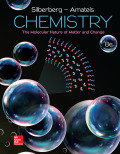
Concept explainers
(a)
Interpretation:
Concept introduction:
Hess’s law is used to calculate the enthalpy change of an overall reaction that can be derived as a sum of two or more reaction. According to Hess’s law
Enthalpy is a state function so the value depends upon the initial state and final state not on the path so
(a)
Answer to Problem 9.75P
Explanation of Solution
The enthalpy change of the following reaction is
The enthalpy change of the following reaction is
The enthalpy change of the following reaction is
The enthalpy change of the following reaction is
The enthalpy change of the following reaction is
Reverse the equation (5).
The enthalpy change for the reaction (6) is calculated as,
Multiply the equation (2) by
The enthalpy change for the reaction (7) is calculated as,
Add equation (1),(3), (4), (6) and (7).
The enthalpy change of the final reaction (8) is
The expression to calculate
Substitute
(b)
Interpretation:
Whether
Concept introduction:
The standard enthalpy of formation
Standard state includes
(b)
Answer to Problem 9.75P
Explanation of Solution
The chemical equation for the formation of
The enthalpy of formation
When the enthalpy of formation is negative then the compound formed is relatively more stable as compared to the elements. Therefore,
When the enthalpy of formation is negative then the compound formed is relatively more stable as compared to the elements.
(c)
Interpretation:
Concept introduction:
The standard enthalpy of reaction is calculated by the summation of standard enthalpy of formation of the product minus the summation of standard enthalpy of formation of product at the standard conditions. The formula to calculate the standard enthalpy of reaction
Here, m and n are the stoichiometric coefficients of reactants and product in the balanced chemical equation.
(c)
Answer to Problem 9.75P
Explanation of Solution
The chemical equation for the formation of
The formula to calculate the standard enthalpy of reaction
Substitute
(d)
Interpretation:
Whether
Concept introduction:
The standard enthalpy of formation
Standard state includes
(d)
Answer to Problem 9.75P
Explanation of Solution
The chemical equation for the formation of
The enthalpy of formation
The enthalpy of formation
The compound with the more negative enthalpy of formation is relatively more stable than the compound with the less negative enthalpy of formation. Therefore,
The compound with the more negative enthalpy of formation is relatively more stable as compared to the compound with the less negative enthalpy of formation.
Want to see more full solutions like this?
Chapter 9 Solutions
EBK CHEMISTRY: THE MOLECULAR NATURE OF
 ChemistryChemistryISBN:9781305957404Author:Steven S. Zumdahl, Susan A. Zumdahl, Donald J. DeCostePublisher:Cengage Learning
ChemistryChemistryISBN:9781305957404Author:Steven S. Zumdahl, Susan A. Zumdahl, Donald J. DeCostePublisher:Cengage Learning ChemistryChemistryISBN:9781259911156Author:Raymond Chang Dr., Jason Overby ProfessorPublisher:McGraw-Hill Education
ChemistryChemistryISBN:9781259911156Author:Raymond Chang Dr., Jason Overby ProfessorPublisher:McGraw-Hill Education Principles of Instrumental AnalysisChemistryISBN:9781305577213Author:Douglas A. Skoog, F. James Holler, Stanley R. CrouchPublisher:Cengage Learning
Principles of Instrumental AnalysisChemistryISBN:9781305577213Author:Douglas A. Skoog, F. James Holler, Stanley R. CrouchPublisher:Cengage Learning Organic ChemistryChemistryISBN:9780078021558Author:Janice Gorzynski Smith Dr.Publisher:McGraw-Hill Education
Organic ChemistryChemistryISBN:9780078021558Author:Janice Gorzynski Smith Dr.Publisher:McGraw-Hill Education Chemistry: Principles and ReactionsChemistryISBN:9781305079373Author:William L. Masterton, Cecile N. HurleyPublisher:Cengage Learning
Chemistry: Principles and ReactionsChemistryISBN:9781305079373Author:William L. Masterton, Cecile N. HurleyPublisher:Cengage Learning Elementary Principles of Chemical Processes, Bind...ChemistryISBN:9781118431221Author:Richard M. Felder, Ronald W. Rousseau, Lisa G. BullardPublisher:WILEY
Elementary Principles of Chemical Processes, Bind...ChemistryISBN:9781118431221Author:Richard M. Felder, Ronald W. Rousseau, Lisa G. BullardPublisher:WILEY





